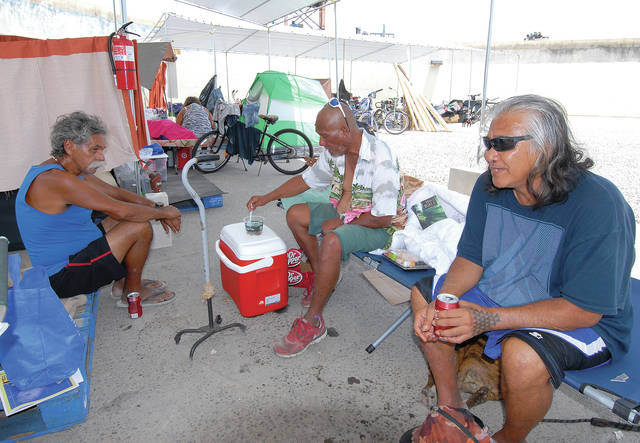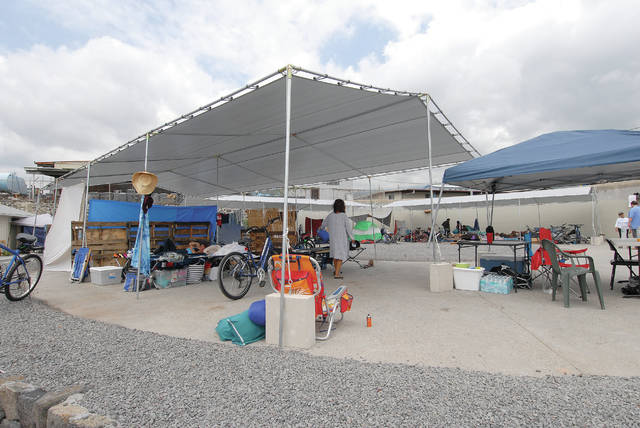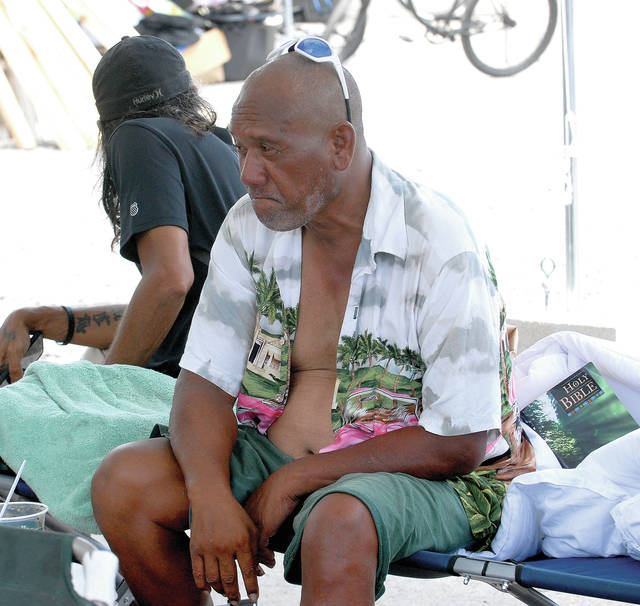Hale Kikaha takes shape: Residents settling in at the new homeless camp
KAILUA-KONA — More than a week into its existence, an open-air homeless camp at Hale Kikaha has become a symbol for a community in transition.
Linda Vandervoort was more than a little skeptical when she learned of the county’s plan to tuck a large group of homeless people ushered out of Old Airport Park last week into a tight corner of a small county parcel in the heart of the Old Kona Industrial Area.
Now, she’s helping run the camp — and growing more optimistic about its value and sustainability with each passing day.
“This is actually a miracle,” said Vandervoort, who’s been working with Kona’s homeless in official and unofficial capacities for years. “If you told me two weeks ago you were going to put this specific group of people together in a place like this, I would have said, ‘What are you talking about? That’ll never work.’”
But it has worked, at least so far. And the bumps in the road have been predictable.
The area was initially slated for 20 people, but within a week grew to 32. That is the site’s maximum capacity, Vandervoort said.
“This is proof,” she added, “that if we have a designated spot for our homeless population, they will utilize it.”
Anyone who has ever lived with a roommate knows altercations inevitably arise when even two people are packed in close quarters. Multiply that by a factor of 16, add to it the volatility of a population unaccustomed to living by an imposed set of external guidelines and suffering from a higher than normal incidence of addiction and mental health concerns, and friction is bound to ensue.
Police have been called into the site on a daily basis, Vandervoort said, sometimes as often as three time per day to extinguish exchanges. But behavioral issues are lessening, she said, as people adapt to their new living conditions.
Former chronically homeless individuals living in the adjacent micro units constructed last year have clashed with their new neighbors. And some of the new arrivals initially bucked at the rules, which include no unregistered visitors after 5 p.m., no drugs or alcohol on the premises, and designated smoking areas.
But no one has left, and the county hasn’t been forced to expel anyone. One woman was suspended from the area for 12 hours following several bouts of misbehavior, Vandervoort said, but she hasn’t made any trouble since.
“This is a raw, authentic group of people,” Vandervoort said. “When you talk to people, they tell you how it is. It’s real. There’s no guesswork.”
The straight-forward nature of many of the camp’s residents allows, in some ways, a better foundation for conflict resolution than what one might in other social settings.
“Ever since this space opened, everybody is wanting to come here now,” said Kuuipo, 20, adding some of what she saw during the last month spent living in a tent at the end of the Old A runway frightened her. “We have fights and stuff over here, but we all come back as family.”
The atmosphere Wednesday afternoon was peaceful and cordial as campers came and went from the site on bicycles while others utilized the on-site shower or beat the heat under the shade of canopies.
A security guard sat quietly near the front of the camp with a few of its residents. RMT Enterprises Security Division provides 24-hour security at the site.
“This is a good transitional piece, going from no boundaries to here where we have some,” Vandervoort said. “Because the world, when we go to reintegrate, there’s going to be guidelines.”
As Hale Kikaha has developed, it’s become clear that it can function successfully as a transitional piece — the first step in the process of moving people into permanent housing.
The guidelines have allowed social service providers offering mental health and substance abuse counseling access to an otherwise transient and often resistant population. At Hale Kikaha, resident engagement with such services is mandatory.
The county has also entered every member of the camp into the state’s Homeless Management Information System, which helps homeless advocates keep track of homelessness in Hawaii and ultimately catalogue and enroll people for potential housing and services in the future as they become available.
The homeless who’ve decided to acquiesce to the guidelines at Hale Kikaha have reaped the benefits. The site affords those living there a guarantee of fresh water and two meals every day. The security presence has also drastically reduced incidents of victimization, primarily theft of belongings, which is a rampant problem between homeless living on the streets.
There has been some homeless migration back into Old A since camping there overnight was banned, despite having always been illegal, but not from the segment of people who’ve taken up at Hale Kikaha.
“The majority of people have complied,” Sgt. Roylen Valera, Kona Community Policing Division, wrote in an email to WHT. “Since Aug. 1, 2017, only two citations have been issued for people being in the Old Airport Park after it has closed.”
Valera added illegal camping is an arrestable offense, which police have used to motivate those trying to avoid the rules. He reiterated, however, that the homeless have as much right to the park as anyone else, as long as they’re not there between the hours of 11 p.m.-6 a.m.
In the end, most homeless at the camp prefer their situations over what they had before, Kuuipo said. And they recognize the new potential to one day leave a life outdoors behind.
“If they’re in here, they want to be off the street,” Kuuipo said.
She added, “In so many ways, we don’t feel like we’re cared for. We feel nothing but down to the ground.”
For some at Hale Kikaha, however, that’s beginning to change. Vandervoort, who meets with each resident once in the morning and once at night, said the progress is noticeable after only a week. She expects it will continue.
“There are some moments here that are just amazing,” she said.





